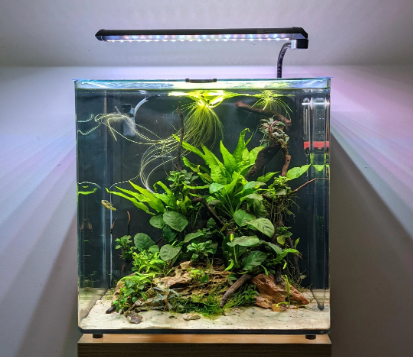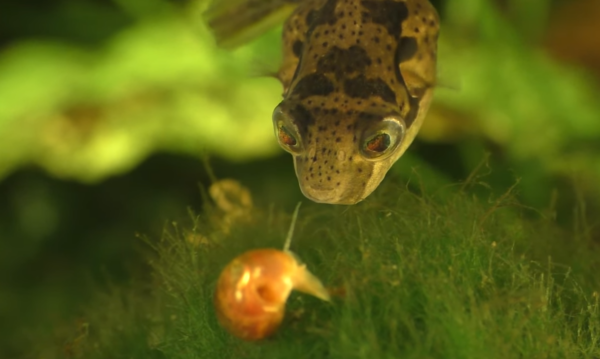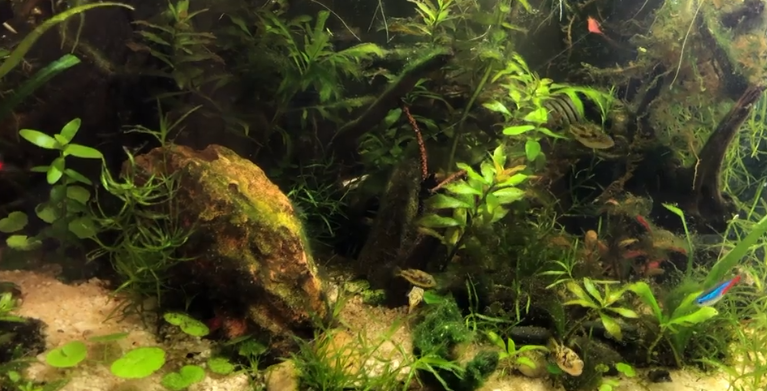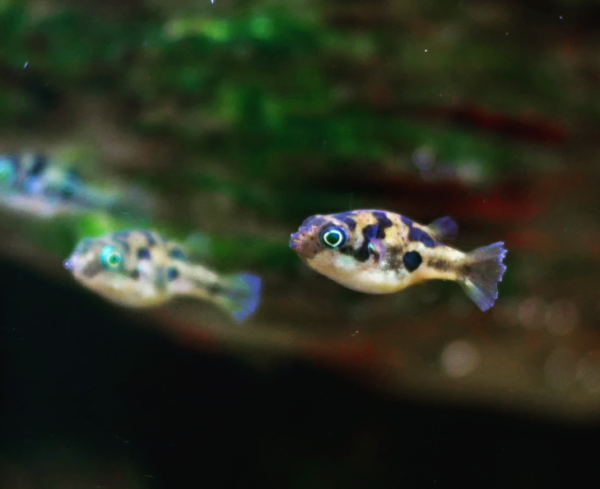[ad_1]
The Dwarf Pufferfish, also known as Pea Puffer or Pygmy Puffer, is a vulnerable freshwater species and is a popular aquarium fish. Pea Puffers are found in the wild, forming large groups to breed and prey on smaller fish, contradictory to typical pufferfish behavior.
Pea Puffers have found their way into the aquarium trade for their unique appearance and puffing mechanism, which refers to their ability to gulp air and inflate their bodies in the face of danger.
However, with increasing demand and overfishing, the Pea Puffer population has rapidly declined in their natural habitats.
In this article, we’ll discuss all the details that you need to know to give care to your Pea Puffer or a group of Puffers. We’ll mostly focus on technical details and necessary tips that may make your job easier.
Pea Puffers Overview
The marine pufferfish and the Pea Puffers are separate species of the same family. They’re one of the 27 pufferfish species adapted to freshwater. However, Pea Puffers are able to adapt to slightly brackish water if required.
The Dwarf Puffers are considered a vulnerable species on the IUCN Red List due to damming, overfishing, and deforestation.
As an aquarist, you must understand that the Pea Puffers require an advanced level of care in terms of nutrition, tank maintenance, and water quality.
| Information Chart | Pea Puffer |
| Scientific Name: | Carinotetraodon travancoricus |
| Family: | Tetraodontidae |
| Care Level: | Moderate to Advanced |
| Temperament: | Semi-aggressive |
| Color: | Greenish-brown coloration with patterns and markings |
| Lifespan: | Up to 5 years |
| Size: | Around 1 to 1.5 inches |
| Diet: | Carnivorous diet |
| Minimum Tank Size: | 5 gallons for a single fish |
| Temperature: | 72 to 82 F (22 to 28 C) |
| Water Conditions: | pH 7.2 to 7.5 Moderately hard water |
| Tank Mate Compatibility | Can be kept alone or in a group. Other peaceful fish species make optimum tank mates. |
Appearance
With a maximum length of 1.5 inches, Pea Puffers are one of the smallest pufferfish in the world. Although Pea Puffers exhibit sexual dimorphism, both males and females are primarily greenish-yellow, with dark spots and iridescence patches on their round and oblong bodies.
Their dorsal fins are located slightly backward and opposite to the anal fins. Both are round and short. The pectoral fins of puffers, on the other hand, are fan-shaped and slightly emarginate. The largest fin of Pea Puffers, the tail fin, is elongated and has a vertical edge.
Females of the Pea Puffers are more round in shape and have a light-colored underbelly. They also lack an iridescent blue-eye wrinkle pattern present in some males.
Types of Pea Puffers
While Pea Puffers are a particular species, there exists a few small pufferfish species that appear similar. Some of them are:
Bumblebee Puffer
Native to Indonesia, the Bumblebee Puffers are a bit larger (2 inches) than Pea Puffers. They’re more aggressive and aren’t suitable for community tanks. They have a more yellowish hue on their body.
Red-tailed Puffer
The Red-tailed Puffer is another pufferfish native to Indonesia, which has a darker body and red tail and eyes. Patterns and spots are visible throughout its body, and it exhibits shoaling behavior in the wild.
Spot-Fin Puffer
Growing to about 1,5 inches, the Spot-fin Puffer has a red eye, spotted body, and fins. They’re peaceful in nature and prefer living and hunting in groups of at least 6. They also are native to Indonesian rivers.
Lifespan of Pea Puffers
The typical lifespan of Pea Puffers is 3 to 5 years.
In the wild, the lifespan of Pea Puffers is negatively impacted through:
- Predators: Larger fish, birds, and other aquatic predators feed on Pea Puffers.
- Habitat destruction: Deforestation and pollution often destroy the natural habitat of Sea Puffers.
- Competition: Pea Puffers need to compete with other large or small fish species for food in the wild.
- Disease and Parasite: Wild Pea Puffers are more susceptible to diseases and parasites than those in artificial waters.
Most of these issues are non-existent in artificial water. However, the lifespan of domesticated Pea Puffers is negatively affected by:
- Poor water quality: Pea Puffers are very sensitive to adverse water quality and parameter changes.
- Improper Diet: Being carnivorous, Pea Puffers rely on your decision of diet choice. Not feeding live or frozen food can decrease their lifespan.
- Overcrowding
- Tank Aggression
- Lack of Hiding Spots
Pea Puffers Size
Pea Puffers can grow Up to 1.5 inches in well-maintained tanks with proper nutrition. The factors that influence their lifespan, may also contribute to a reduced maturity length of Pea Puffers.
Maintain these tips for more positive outcomes:
- Tank size: Despite Pea Puffers being small fish, they need adequate space to swim and explore. Provide a tank size of at least 30 gallons for a group of 6 Pea Puffers for optimum growth.
- Water quality: Regular water changes (about 35% every 1-2 weeks) and employing powerful biological and mechanical filtration promote the growth of Pea Puffers. Also, maintain optimum water parameters like pH, hardness, and zero ammonia and nitrite.
- Offer a varied and proper carnivorous diet.
- Feeding frequency: Feed in small amounts multiple times a day to match their fast metabolism.
- Hiding spots: Provide ample hiding spots in the forms of live plants, rocks, driftwood, and caves.
- Reduce stress: Stress negatively affects growth. Ensure a stress-free environment by reducing sudden parameter changes and removing aggressive tank mates.
- Patience: Pea Puffers grow at a much slower rate than most freshwater fish. Be patient and follow the tips.
Natural Habitat and Origin
Pea Puffers are native to the Western Ghats of Peninsular India. They’re found in the calm rivers and lakes of Kerala and Karnataka. As a migratory species, they often move around the river systems in this region to breed and source food.
This pufferfish species inhabits densely vegetative waters with substrates such as gravels, rocks, clay loam, and sand. They also are found inhabiting paddy fields, ditches, and ponds in these regions.
In the wild, Pea Puffers are found to prefer live plants, such as Duckweed and Amazon Frogbit.
Pea Puffers Care & Tank Set-Up
Let’s now dive into more advanced discussions about the care and tank requirements for Pea Puffers. Before we start, always remember that while we’ll try to give you the most accurate information, each individual fish has its own requirements and preference. Observation is the key.
Tank Size and Specifications
In this section, we’ll discuss the tank size and tank specification requirements for Pea Puffers.
Optimum Tank Size for Pea Puffers
The minimum tank size requirement for Pea Puffers is 5 gallons for a single fish. With the introduction of multiple puffers, the minimum requirements also increase in almost a geometric progression.
However, the recommended tank size is much higher. You shouldn’t go with anything below 10 gallons for a single puffer and 20 for a group of 3. For more members, increase the tank size as required.
A larger tank size also helps them perform their natural, quirky behaviors of glass surfing and substrate play. Glass surfing is when your Pea Puffer wants attention and follows your movements by surfing in the tank. Substrate play, on the other hand, is a territorial behavior of burrowing and arranging substrates.
Tank Shape for Pea Puffers

You can keep your Pea Puffers in any tank shape. But, as they are active swimmers and love observing the movements outside of the tank, horizontal tanks are most suitable for them.
A longer tank also allows you to be more creative with aquascapes and hiding spots, which Pea Puffers prefer to have in their tanks.
When choosing a bigger tank for multiple puffers, focus on the length more than the width and height. A standard 5-gallon aquarium has the following general dimensions:
Length: 16 inches
Width: 8 inches
Height: 10 inches
Filter Type
Pea Puffers have a moderate bioload for their size. Meaning that they produce a significant amount of waste, both in the forms of wasted food and poop. With more bioload, toxic elements in the aquarium, such as ammonia, nitrite, and nitrate, also become risk factors.
To break these chemicals down, beneficial bacteria and powerful filtration are critical.
For Pea Puffer tanks, hang-on back (HOB) filters are sufficient and recommended. With canister filters being more powerful and generating a high water flow, those products aren’t suitable for small Pea Puffers.
A sponge filter may be included as an additional filtration tool, but shouldn’t replace the HOB with mechanical and biological filtration abilities.
The best filter media for Pea Puffers are:
- Filter Sponge: Gentle filter sponges can provide the initial filtration for Pea Puffer tanks.
- Biological Media: Ceramic rings and bio-balls should be added to the HOB.
- Mechanical Filter Pad: Include finer mechanical filter floss in the HOB to trap organic debris.
Substrate
The best substrates for Pea Puffer tanks are the ones that they are habituated to in nature. They often create burrows in the substrate or rearrange them in a territorial way. Therefore, the best substrates include:
- Fine sand: Closely resembling the river beds, fine sands are an excellent substrate choice for Pea Puffers. They can exhibit their burrowing behavior without harming their delicate undersides.
- Smooth gravel: Small, smooth-edged gravels can be chosen as substrate choices for Pea Puffers. Choose gravels that aren’t large and don’t have sharp edges, as the puffers like to explore and move them around.
Bare bottom tanks may also be an efficient option, but we don’t recommend that to hobbyists.
How many Pea Puffers in a 20 Gallon Tank?
A group of 6 Pea Puffers can live in a 20-25 gallon tank.
Water Parameters for Pea Puffers
Pea Puffers are quite sensitive to water parameters and toxin spikes. Therefore, it’s critical to maintain optimum water parameters at all times.
Water Temperature
Pea Puffers prefer a relatively warmer water temperature of 72 to 78F. Keeping the temperature within that range helps with maintaining their metabolic rate and overall activity level. Huge deviations in water temperatures can lead to temperature shock and behavioral changes in your Pea Puffer.
Decreased appetite, compromised immune system, and breeding issues also are prevalent with temperature disparity.
A few tips for maintaining water temperature include:
- Using a powerful heater with temperature control.
- When changing water, precondition it to match the aquarium temperature.
- Change water frequently to reduce water temperature.
- Increase the water flow if you want to cool down the water. Increase flow on the surface level for best results. Use a flow generator.
Water Flow Rate
Pea Puffers are native to calm rivers and lakes, where they aren’t exposed to serious water currents. A water flow rate of 10 GPH is more than adequate to keep healthy Pea Puffers. That’s why HOB filters are the best choice for puffer tanks.
However, if you use a canister filter or have a flow generator installed, here is how you can adjust the water flow rate:
- Install filters with adjustable filter flow to increase or decrease the water flow rate as required.
- Purchase a flow reducer if your filter doesn’t offer a flow adjustment mechanism.
- Modify or use different output accessories to maintain the flow or disperse it over a greater area.
- Use plants and decorations to create barriers against the flow.
- Add a pre-filter sponge to prevent Pea Puffers from getting sucked into powerful filters.
- Position and rotate the filter in a different direction to reduce water flow.
pH Levels
Pea Puffers prefer a moderately basic pH of 7.2 to 7.5. It helps them maintain their acid-base balance in the body, which influences the behavior of blood and body fluids. In addition, pH imbalance may cause issues with gill function and extracting oxygen from the water.
Ion regulation issues and stress level increase are other major symptoms of pH imbalance in water.
To maintain a moderate pH level, consider:
- Regularly testing for pH levels in your fish tank. Keep testing kits handy and try to maintain a routine.
- Knowing your water sources and testing them before mixing them with tank water. Water sources often change, and that can cause a pH spike.
- Using pH buffering substrate like coral or aragonite. They generally increase the pH to an acceptable level.
- Partial water changing. Partial water changes can help maintain optimum pH levels.
- Using driftwood and Indian Almond leaves. These can release tannins in the water to reduce pH levels.
While it’s essential to achieve an optimum pH level, it’s more important to sustain it. While your fish will tolerate a few degrees of deviation, they wouldn’t be able to survive sudden spikes.
Water Hardness
Pea Puffers thrive on moderately hard water that falls within the range of 5 to 15 dGH. GH and KH testing kits are typically used to measure water hardness.
Inaccurate water hardness often leaves the Pea Puffers with stress and health issues. They may also develop osmotic stress, where an imbalance of solutes in the body and external environment occurs.
To increase water hardness, add commercially available mineral additives to the water. And to reduce hardness, try mixing water sources or using water softeners.
Pea Puffers Tank Landscape
Hiding places are critical for the well-being of Pea Puffers. Being native to rivers with dense vegetation, they prefer exploring and hiding behind live plants, driftwood, and smooth rocks.
Best Plants for Pea Puffer Tanks
Most plants with soft and broad leaves are suitable for Pea Puffers. Some of them may include:
- Java Moss: A hardy and low-maintenance species of plants that can be anchored to driftwood.
- Java Fern: Well-suited for low-light conditions, this plant has broad, green leaves to hide the puffers.
- Anubias: Slow-growing plant with thick leaves, ideal for Pea Puffers.
- Amazon Sword: Larger plants to add a lush to the tank.
- Water Sprite: Found in the natural Pea Puffer environment, this fast-growing plant improves water quality.
- Duckweed: Also found in a natural setting with Pea Puffers, this plant provides shade and cover.
Worst Plants for Pea Puffer Tanks
There are no such common aquarium plants that are harmful to Pea Puffers.
But, you should avoid,
- Plants that can easily be uprooted, like Vallisneria.
- Plants with thin leaves, like Cabomba.
- Small and delicate plants, like Baby Tears.
- Weak carpeting plants, like Hairgrass.
Decorations for Pea Puffers Tanks
Decorations are used to mimic the natural aquascape of the inhabiting fish species. In case of Pea Puffers, decorations may include:
- Driftwood: Provides hiding spots for Pea Puffers.
- Rocks and Caves: Also offers great hiding spots and shelter.
- Live Plants: Enhances visual appeal, provides shelter, and allows exploration.
- Indian Almost leaves: Maintains water quality and allows Pea Puffers to nimble on them.
- PVC Pipes: Creates additional hiding spots.
- Smooth Toys.
Lighting for Pea Puffers Tank
You don’t need to commit to any special lighting setting to keep Pea Puffers. As you may be including live plants to your aquarium, make sure to use brighter white lighting. However, try to avoid intense lighting, as Pea Puffers are from waters with subdued and dappled lighting.
If possible, consider natural lighting to follow the day-night cycle. If not, use timers to offer at least 8-10 hours of lighting.
Feeding Pea Puffers

A carnivorous diet is essential to keep your Pea Puffers healthy. Here are a few nutritional options that are suitable for the same.
Best Diet for Pea Puffers
Offer shrimp, daphnia, mosquito larvae, and bloodworms in live or frozen forms to fulfill their natural appetite.
The mouths of Pea Puffers are designed to break into invertebrates, especially snails. And they should be an essential part of their diet. Offer small, soft-shelled snails like Malaysian Trumpet Snail or Bladder Snail.
- Microworms or Vinegar Eels
These small live food options can be lucrative for mature Pea Puffers.
Newly hatched brine shrimps are a great option for juvenile Pea Puffers.
Commercially available carnivorous pellets contain high protein and other nutritional elements.
How often should you feed Pea Puffers?
As they have a pretty high metabolic rate, feed at least thrice a day in small portions to your Pea Puffers.
Pea Puffers Behavior and Temperament
In the wild, Pea Puffers are seen to be swimming in large groups. But, due to space confinement and territorial behaviors, they can show semi-aggressive behavior in artificial waters.
They’re predominantly curious creatures and love to constantly explore their environment, plants, decorations, and new fish. But, they don’t particularly develop a liking towards other curious creatures and may chase them away.
Pea Puffers often nip on other fish. Either as a result of their aggression or mistaking them as food, their predatory instinct often proves harmful to other non-aggressive species.
Like other pufferfish species, Pea Puffers also rest near the substrate with their body partially burrowed inside the sand. They often appear more pale and flatter when resting. However, they swim around the surface during the day in search of food or to gulp air.
Are Pea Puffers lone or social in nature?
Pea Puffers aren’t social in the same way as schooling fish but they can form loose groups in the wild to stay safe.
Pea Puffers Tank Mates

The ideal and bad tank mates for Pea Puffers are discussed in this section.
Ideal Pea Puffer Tank Mates
Mostly peaceful, non-aggressive, and similar-sized fish species are suitable for Pea Puffers. Some examples of that may include:
- Small schooling fish, such as Ember Tetra, Celestial Pearl Danios, and Rasboras.
- Otocinclus Catfish. Small and peaceful algae-eaters.
- Kuhli Loaches. Small, peaceful, nocturnal species that coexist pretty easily with Pea Puffers.
- Dwarf shrimp species, such as Cherry Shrimp and Amano Shrimp, can be kept with Pea Puffers.
Bad Tank Mates for Pea Puffers
It’s generally best to avoid tank mates that are aggressive and have the potential to compete for food with the puffers. Some incompatible fish species are:
- Other pufferfish.
- Nippy, aggressive fish species, even some tetras.
- Fast and active swimmers. They may stress out slow-moving Pea Puffers.
- Boisterous fish species may outcompete them for food and space.
- Bottom-dwelling cichlids.
- Very small fish or fry that can be consumed by Pea Puffers.
Breeding Pea Puffers
Pea Puffers are pretty active breeders and lay eggs on rocks, driftwood, and leaves. The breeding process is moderately challenging. The basic Pea Puffer breeding process involves:
- Sexing Pea Puffers: Identifying male and female Puffers may be challenging due to menial sexual dimorphism. But, females appear rounder in mating sessions.
- Separating breeding tank: Separating the breeding pair to another tank with suitable water parameters and a bit colder water temperature increases the chance of them laying eggs. Provide them with enough hiding space and surfaces to lay eggs.
- Introduce the pair to the breeding tank. One male and one female are best for Pea Puffer breeding.
- Spawning: Females lay eggs, and the male often assists in the process.
- Egg care: remove the eggs promptly to avoid them getting eaten by the adult puffers.
- Incubation: The eggs hatch in a few days with appropriate water conditions and gentle aeration.
- Fry care: Infusoria and other microorganisms should be offered as their first food. Brine shrimp may be offered after a few days.
Pea Puffers Common Disease and Treatment

A few common Pea Puffer diseases and their treatments are:
Ich
Common parasitic infection that causes white spots to appear. The symptoms usually include flashing behavior and lethargy. Treatment options range from raising the water temperature to using copper-based medication.
Velvet
Another parasitic infection, which causes a golden velvety appearance on the body of the fish. Rapid breathing and lethargy are common symptoms. Treating the entire tank with copper-based medication is considered an effective treatment option.
Fin Rot
Frayed, tattered, or eroded fins are common symptoms of fin rot. In developed stages, it may spread to the body of your Pea Puffer. Antibiotics and improved water conditions are recommended treatment options.
Fact about Pea Puffers
- Pea Puffers can tolerate slightly brackish water.
- Despite their cute appearance, they can be quite aggressive.
- Pea Puffers are snail specialists and can break through their tough shells.
- They’re curious creatures and love to follow the keeper around the tank.
- They prefer live food that can be hunted and consumed.
- Individual Pea Puffers have vibrant personalities and exhibit unique, entertaining behavior.
Are Pea Puffers Right for You?
If you can follow this care guide diligently, there is no reason you can’t keep Pea Puffers. Although they may need special care, Pea Puffers are quite friendly towards their human keepers.
FAQ
Yes. Pea Puffers require advanced care, and we don’t generally recommend them to beginner aquarists.
Pea Puffers love to eat snails. Their teeth and mouth are specially designed to break and eat the shellfish.
They can be housed with other peaceful fish, given enough tank space and nutrition. But they don’t particularly like to be around other members.
The Bottom Line
Hopefully, you’ll now be able to give proper care to your Pea Puffer by going through this in-depth care guide. We wish you all the best in caring for your Pea Puffers.
[ad_2]
Source link
